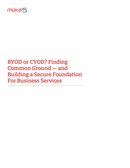Preview new “BYOD or CYOD” Whitepaper
We’ve just published a new BYOD/CYOD whitepaper. It’s one of the first whitepapers to address this new trend. Here’s a preview of a portion of it, with the ability to download the complete document.
BYOD or CYOD? Finding Common Ground — and Building a Secure Foundation For Business Services
Here’s a sweeping statement: Organizations today face more endpoint management challenges than at any time in history. And, the organizations that address those challenges most effectively will likely get the best business results as well.
What constitutes an effective response, though?
Answering that question means first understanding that both the available range of endpoints, and the ways those endpoints are utilized, have become more diverse than ever. Today, employees typically want a platform (operating system) that is familiar and comfortable for them, thus supporting the way they work better than alternatives. The fact that endpoints are increasingly mobile has clear ramifications as well: employees typically want to use solutions such as laptops, at times from locations, and via networks that the organization didn’t anticipate and can’t control.
This situation has led to a “fork in the road” in which organizations consider which of two strategies they’ll pursue in response:
• BYOD (bring your own device): Employees purchase and own the endpoints, use them for business purposes, and the organization tries to configure and manage those endpoints in such a way as to make them as suitable for business purposes as possible, while also respecting employee privacy.
• CYOD (choose your own device): The organization purchases, owns, configures, and manages the endpoints,
but gives employees a range of choices from which to select.
Each strategy implies strengths and weaknesses. However, it’s becoming increasingly clear that those strengths and weaknesses aren’t as obvious and objective as they might at first seem; many subtleties apply. For instance, BYOD strategies that seem to promise higher user satisfaction because the user owns the device, also put the initial capital expense burden on the user. Similarly, CYOD strategies that seem to imply higher costs because the organization must purchase devices, can also translate into lower TCO (total cost of ownership) because the organization finds it much simpler to manage the device over time to best business effect.
In this whitepaper, we’ll discuss some of the challenges, concerns, and benefits these two models involve, and then consider how a containerized approach can help fortify security, reduce costs, simplify management, and minimize compliance complexities for both of these models.
Running the gauntlet: Typical challenges and concerns for the organization to consider.
Whether an organization selects BYOD, CYOD, or a hybrid approach (such as BYOD from a limited list of approved endpoints or use cases), certain challenges will usually arise. These should be considered in advance, along with the corresponding risks that can emerge if they aren’t addressed adequately.
Here’s the registration form to download and read the complete “BYOD or CYOD? Finding Common Ground — and Building a Secure Foundation For Business Services” whitepaper.
BYOD or CYOD?
Finding Common Ground — and Building a Secure Foundation For Business Services

